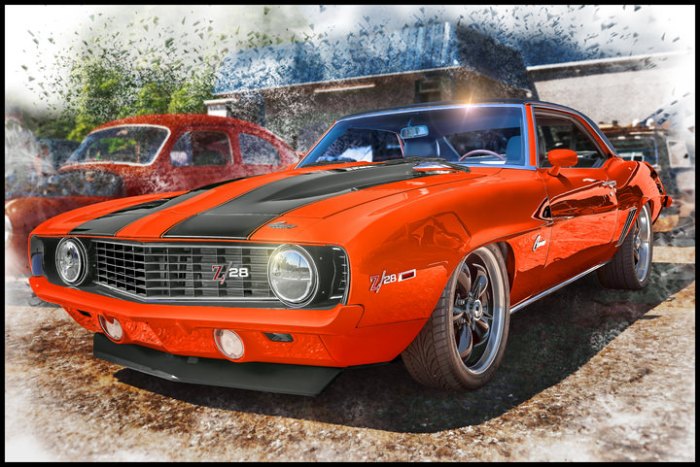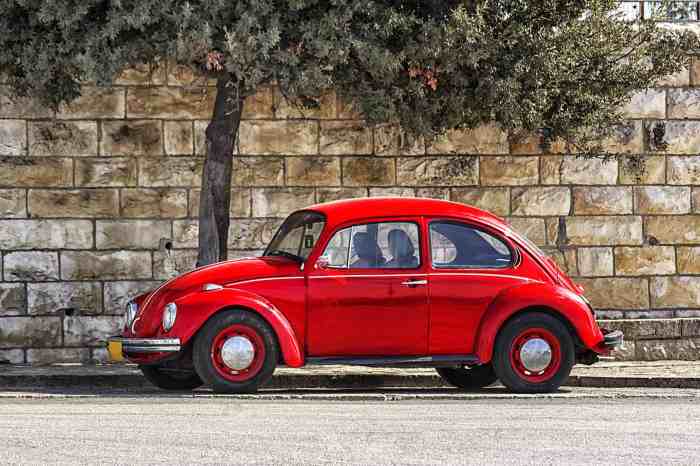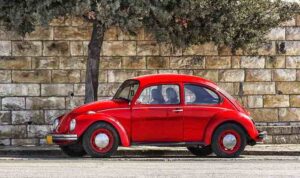Classic car restoration, a journey filled with passion and dedication, where vintage vehicles are brought back to life with expertise and flair. Get ready to dive into the world of reviving automotive classics!
Introduction to Classic Car Restoration
Classic car restoration is the process of bringing vintage vehicles back to their former glory. It involves repairing, refurbishing, and sometimes rebuilding various parts of the car to ensure it looks and functions like it did when it first rolled off the assembly line.
Preserving vintage vehicles is important because it allows us to maintain a piece of automotive history. These classic cars represent a bygone era of design and craftsmanship, and restoring them helps to keep that history alive for future generations to appreciate.
Restoring a classic car requires a great deal of passion and dedication. It’s not just about fixing up a car; it’s about honoring its legacy and ensuring that it continues to turn heads and evoke nostalgia for years to come.
Challenges of Classic Car Restoration
- Locating original parts can be a time-consuming and costly process.
- Restoring vintage cars often requires specialized knowledge and skills that may not be readily available.
- Patience is key, as the restoration process can be lengthy and unpredictable.
Essential Tools and Equipment

When it comes to classic car restoration, having the right tools and equipment is crucial to getting the job done right. Whether you’re a seasoned pro or just starting out, here are some essential items you’ll need to have in your garage:
Basic Tools List
- Socket set and wrenches
- Screwdrivers (both flathead and Phillips)
- Pliers and wire cutters
- Hammer and rubber mallet
- Torque wrench
- Jack and jack stands
- Dremel or rotary tool
Having these tools on hand will help you tackle a variety of tasks during the restoration process, from removing bolts to shaping metal.
Specialized Equipment Importance
Specialized equipment like sandblasters and paint booths play a crucial role in achieving professional results when restoring a classic car. Sandblasters help remove rust and old paint quickly and efficiently, while paint booths provide a controlled environment for painting, ensuring a smooth and even finish.
Investing in high-quality tools is essential for a successful restoration project. Not only will they make the job easier and more efficient, but they will also help you achieve better results in the long run.
Steps in the Restoration Process
Restoring a classic car involves several key steps that are essential to bringing the vehicle back to its former glory. Each stage presents its own set of challenges that require patience, skill, and attention to detail. Here, we will discuss the typical steps involved in the restoration process, the challenges faced during each stage, and share tips for beginners on how to prioritize tasks and stay organized.
Disassembly
Disassembly is the first step in the restoration process, where the classic car is taken apart piece by piece. This stage can be challenging as it requires careful labeling and organization of all parts to ensure they can be correctly reassembled later on. Beginners should take their time during disassembly, document each step, and store parts in a safe and organized manner to avoid confusion later.
Bodywork
The bodywork stage involves repairing any dents, rust, or damage to the car’s body. Challenges in this stage include matching paint colors, sourcing replacement panels, and ensuring the body is properly aligned. Beginners should focus on mastering basic bodywork techniques, investing in quality tools, and seeking guidance from experienced professionals to achieve the best results.
Painting, Classic car restoration
Painting is a critical stage in the restoration process that can make or break the final look of the classic car. Challenges during painting include achieving a smooth finish, preventing runs or drips, and ensuring proper curing of the paint. Beginners should prioritize surface preparation, practice painting techniques on scrap materials, and consider seeking professional help for complex paint jobs.
Reassembly
Reassembly is the final stage of the restoration process, where all parts are put back together to complete the classic car. Challenges in this stage include fitting parts properly, troubleshooting any mechanical issues, and ensuring everything works as it should. Beginners should refer to their documentation from the disassembly stage, take their time during reassembly, and seek assistance from experts if needed to avoid costly mistakes.
Sourcing Parts and Materials
Finding authentic parts for classic cars is crucial to maintain the originality and value of the vehicle. Using original components ensures a proper fit and function, as well as preserving the historical accuracy of the car. While aftermarket parts may be more readily available and cheaper, they can sometimes lack the quality and authenticity of original parts.
Where to Find Authentic Parts
One of the best places to find authentic parts for classic cars is through specialty auto parts stores that cater specifically to vintage vehicles. These stores often have a wide selection of original parts or can help source them for you. Online marketplaces and forums dedicated to classic car enthusiasts are also great resources for finding rare or hard-to-find parts.
Importance of Original Components
Using original components not only ensures a proper fit and function but also maintains the historical accuracy and value of the classic car. Original parts are often made from higher quality materials and are designed to work seamlessly with the vehicle’s existing components. While aftermarket parts may be more affordable, they can sometimes compromise the integrity and authenticity of the restoration project.
Strategies for Sourcing Rare Materials
When sourcing rare or hard-to-find materials for classic car restoration, networking with other enthusiasts and collectors can be incredibly helpful. Attending classic car shows, swap meets, and auctions can provide opportunities to connect with sellers who specialize in rare parts. Additionally, reaching out to restoration shops or salvage yards that focus on vintage vehicles may lead to the discovery of elusive materials needed for your project.
Budgeting and Cost Considerations
When embarking on a classic car restoration project, creating a budget is crucial to ensure you stay on track financially. By carefully planning and considering all potential costs, you can avoid overspending and manage your expenses effectively.
Creating a Budget
Before starting the restoration process, it’s essential to Artikel all the necessary expenses you may incur. This includes costs for parts, materials, tools, labor, and any unforeseen expenses that may arise during the project. By estimating each expense and setting a budget limit, you can prevent financial surprises along the way.
Cost-Saving Techniques
- Research and Compare Prices: Take the time to research and compare prices for parts and materials from different suppliers. Look for discounts, promotions, or second-hand options to save money without compromising quality.
- DIY Tasks: Consider performing certain tasks yourself instead of hiring professionals. Simple tasks like sanding, painting, or interior detailing can be done with the right tools and guidance.
- Reuse and Recycle: Explore the option of reusing or recycling parts from the original car whenever possible. This can save you money on purchasing new components while preserving the authenticity of the vehicle.
Unexpected Expenses
- Hidden Rust or Damage: During the restoration process, you may uncover hidden rust or structural damage that requires immediate attention. Budgeting for potential repairs in advance can help you address these issues without exceeding your budget.
- Specialized Tools or Equipment: Certain restoration tasks may require specialized tools or equipment that you didn’t initially account for. Always be prepared for additional expenses related to tools or machinery needed to complete the project.
- Shipping and Handling Fees: When sourcing parts or materials from different suppliers, don’t forget to factor in shipping and handling fees. These costs can add up quickly and impact your overall budget if not considered from the beginning.
Preservation vs. Modification: Classic Car Restoration

When it comes to classic car restoration, one of the biggest decisions enthusiasts face is whether to preserve a car’s originality or customize it to their preferences. Both approaches have their own merits and challenges, impacting the overall value and appeal of the restored classic car.
Preservation of Originality
Preserving a classic car’s originality involves retaining as many of its factory components and features as possible. This approach appeals to collectors and purists who value authenticity and historical accuracy. By keeping the car in its original state, enthusiasts can showcase the design, engineering, and craftsmanship of a bygone era. Examples of famous classic car restorations that focused on preservation include the Pebble Beach Concours d’Elegance-winning 1931 Duesenberg Model J and the well-documented restoration of Steve McQueen’s 1968 Ford Mustang GT from the movie “Bullitt.”
Customization and Modification
On the other hand, customizing a classic car allows enthusiasts to add modern amenities, improve performance, and create a unique personalized vehicle. While modifications can enhance the driving experience and aesthetic appeal, they may also detract from the originality and historical significance of the car. Some famous classic car restorations that underwent extensive modifications include the Ringbrothers’ 1965 Ford Mustang “Producer” and the ICON Derelict series, which combines vintage bodies with modern drivetrains and features.
Impact on Value
The decision to preserve or modify a classic car can have a significant impact on its value. Fully restored and original classic cars often command higher prices at auctions and are more sought after by collectors seeking historically accurate vehicles. On the other hand, custom-built or modified classic cars may appeal to a different segment of enthusiasts who prioritize personalization and performance enhancements. Ultimately, the value of a restored classic car is subjective and depends on the preferences of potential buyers.
